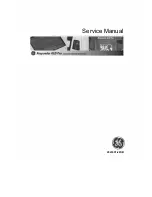
25
Alarm relays are single pole-double throw (SPDT). When an alarm is activated, the coil is energized.
When an alarm activates,
AL1
,
AL2
, or
AL3
(as appropriate) appears periodically in the display.
MODEL SOLU COMP II
SECTION 5.0
PROGRAMMING THE ANALYZER
5.4 CONFIGURING ALARMS AND ASSIGNING SETPOINTS
5.4.1 Purpose
This section describes how to do the following:
1.
assign an alarm relay to the ozone reading or temperature or use it to signal a fault condition,
2.
set the alarm logic to high or low,
3.
assign values to the alarm setpoints,
4.
set the alarm deadbands.
ALARM RELAYS MUST BE CONFIGURED BEFORE ASSIGNING SETPOINTS.
5.4.2 Definitions
1.
ASSIGNING ALARMS. There are three alarms (
AL1
,
AL2
, and
AL3
). Alarms 1 and 2 are for the sensor. They
can be made to activate on either the ozone reading or the temperature. Alarm 3 can be assigned to the sen-
sor or it can be used as a fault alarm. The fault alarm activates when a fault exists in the sensor or analyzer.
2.
FAULT ALARM. A fault condition exists when the Solu Comp II detects a problem with a sensor or with the ana-
lyzer that is likely to cause seriously erroneous readings. If Alarm 3 was programmed as a fault alarm, the
alarm 3 relay will activate. The word
Fault
will appear alternately in the display with the reading.
3.
ALARM LOGIC, SETPOINTS, AND DEADBANDS. See Figures 5-1 and 5-2.
FIGURE 5-1. High Alarm Logic
The alarm activates when the ozone concentration
exceeds the high setpoint. The alarm remains activat-
ed until the reading drops below the value determined
by the deadband.
FIGURE 5-2. Low Alarm Logic
The alarm activates when the ozone concentration drops
below the low setpoint. The alarm remains activated until
the reading increases above the value determined by the
deadband.
















































